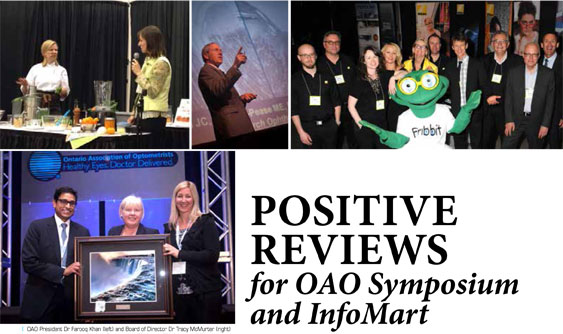By Brian P. Dunleavy
When your optical shop sells sunwear to 100 per cent of its clients, you’re bound to see more than a few requests for prescription wrap sunlenses.
And that’s the challenge Gina Kay, optician and co-manager of the Toronto location of Cristall Opticians, faces daily. As many as 10 per cent of the lenses dispensed at her store are prescription wraps, and she has seen a significant increase in demand for the product over the past couple of years, particularly among presbyopes who prefer progressive lenses.
“I used to say ‘no’ a lot,” says Kay, whose family has owned Cristall, which has three locations in southern Ontario, for more than 50 years. “No to prescription wraps. No to progressive wraps. Clients would beg me, and say, ‘But I’ll pay more,’ and I’d have to tell them, ‘Sorry. We just don’t feel confident in the lens technology available.’ That was especially the case if they had an unusual frame preference. Now I don’t have to say ‘no’ anymore.”
Historically, eyecare professionals (ECPs) seeking prescription wrap sunlenses for their clients had to rely on sunglass manufacturers for supply. Unfortunately, many of these lenses were characterized by spotty optical performance, particularly in the periphery – or, as optician Paul Boyko, Jr. says, “from the curve out”. These problems were even more common in progressive lenses or bifocals.
“We always had issues with wrap lenses and distortion was the biggest problem,” explains Boyko, owner of Windsor-based Visions of Canada.
Now, several spectacle lens and sunglass manufacturers are offering enhanced prescription wrap technology, and the biggest improvements are being made in progressive lens designs. Boyko is taking advantage of what he calls “the evolution” of prescription wrap lens design to develop his own line of golfing eyewear called Visions for Golfing. Kay says Cristall uses wrap lenses from a handful of manufacturers but the shop also has an exclusive distributorship arrangement with a high-performance prescription sports sunwear line.
“We can now offer a progressive wrap lens with confidence,” Kay notes. “This opens up a lot of opportunities for us, and for our clients.”
Still, there are important things to consider when dispensing lens designs that incorporate new wrap technology:
Finish what you start
Boyko says his high-performance edger is key to his success dispensing new prescription wrap lenses; if you finish in-house—or use an outside lab—make sure the edger being used to cut your wrap lenses is equipped to do so.
Manage client expectations
Even with improvements to wrap technology, clients should expect to pay more, especially in progressive designs. Eyewear with prescription progressive wrap lenses can fetch as much as $1,000 at retail—great for ECPs seeking to maximize profits but, perhaps, difficult to swallow for some clients. Make sure you explain the technology and the enhanced vision it promises and remind clients that they will be wearing a high-performance product.
“And even the best of the best will have some peripheral distortion,” Kay emphasizes. “But if you tell clients what to expect with the product, they’ll be happy.”
Adds Boyko: “I’ve had clients wearing new progressive wraps rate their lenses a 20 on a scale of one to 10. But we take a lot of time educating them on what this eyewear can and can’t do for them.”
Research the right wrap
Kay and Boyko both note that, as with all spectacle lenses, some wrap designs are better than others. While there is some parity in single-vision, the differences in quality are very apparent in progressives. Before pushing wraps, make sure you are using designs patients will be happy with.
“You can’t do wraps on the cheap,” advises Kay. “With the prices clients will be paying, expectations will be high and that’s where you can get into trouble. The best way to make sure clients are happy is to make sure you are selling the best product.”










 Silmo President Philippe Lafont took time to speak with Envision: seeing beyond magazine about the upcoming show and how his team is responding to new ways of doing business. Here is our interview:
Silmo President Philippe Lafont took time to speak with Envision: seeing beyond magazine about the upcoming show and how his team is responding to new ways of doing business. Here is our interview: 


